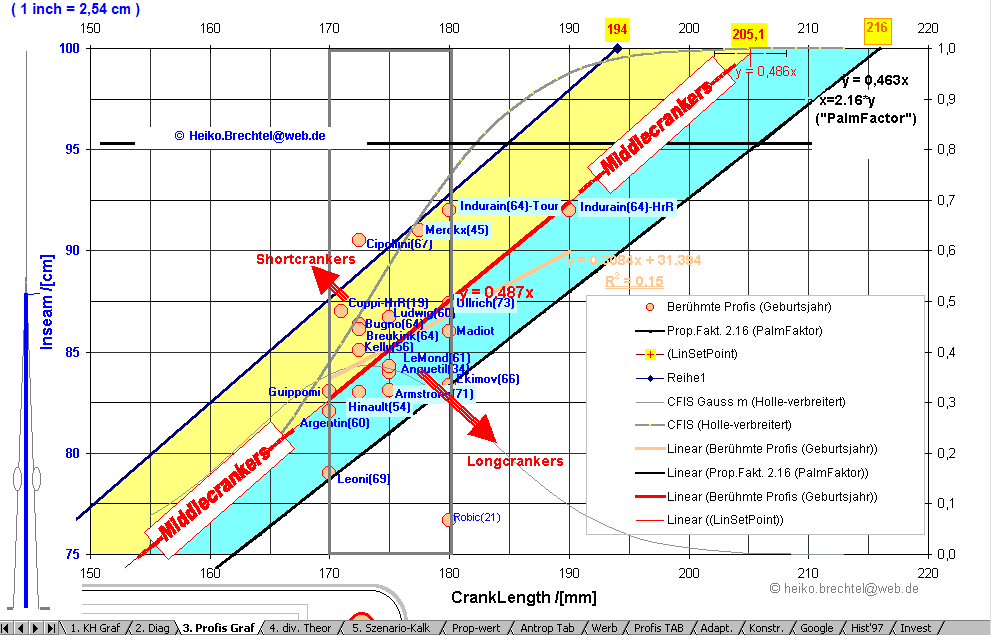Important hint for crank elongation: Adaption is required!
crank elongation enables
and
requires (in most cases) growth of otherwise not
(or little) used muscle areas.
Especially with (on shorter cranks) very good trained bikers the well
trained "round pace" is disturbed,
till muscle adaption has
been achieved! 1)
Adaption - depending on how much elongation - needs some time! 2)
(And this, BTW, also may be the main reason, why many of test
based analyses are inconclusiv or contradictiv)
Do NOT compensate performance slump by applying too much force!!
While adapting pay attention to your knees. If you get signales from
there, probably you are trying to compensate. Reduce the pedalforce!
Efficient adaption training is with high (even exaggerated)
cadence and low to medium pedal force.
Not until you have reached "harmonic motion" apply the full power.
From what is said above, it should be clear, that an only occasional
elongation (e.g. for the big race!) will not work!
Crank shortening
On the other hand the change from longer to shorter cranks should be
always
uncritical.
There is no need for musclegrowth (some muscleareas are not longer
required - but that's not a problem).
The only need is for coordinative adaption. Depending on the biker,
this can be reached in a matter of houres or even minutes. 3)
Optimum region
Everyone has ("somewhere") his/her optimum (at a given time (for a given
purpose:-)).
Near the optimum, the influence of small deviants is only small.
If your cranklength is in the optimal region,
then you should'nt waste time and money, trying to optimize the last
half millimeter,
because this simply makes no sense!
Cranklength is biomechanicaly very relevant - but no panaceas.
Some considerations and
tendencies when choosing cranklength,
depending on...
...Cyclist
shorter <= less - ambitous sport - more =>
longer
...Discipline
Long distance / Time trial => longer
frequently starts, cycling in standing position, climbing => longer
shorter <= circuit race
...Body sizes
shorter <= rel. long tibia || rel. long femur
=> longer
shorter <= smal foot || Bigfoot :-0 => longer
shorter <= full figured |(belly!)| lean => longer
shorter <= aerodyn |ears| distant => longer
...Bicycle
SingleSpeed => longer
* * *
Corner clearence
When elongating the cranks, bear in mind, that cornering clearance
is reduced.
While deeper pedals may be an aerodynamical advantage (Cyclist sits
also deeper) too little cornering clearance is dangerous.
For mountainbikers, fatter tyres can increase the ground clearance.
* * *
You may
tell us, if
you have questions or
think, there should be (even) more sense in this site. :)
*
1)
Walking and running is not biking. Muscle adaption is typical for every
good biker. And every good - but nonbiking - athlete will reach
significant improvement after only some days of bicycle training. Fast
(and maybe only small) adaption effects may be seen
with gymnasts,
because they regularly train a very broad range of movements and
muscles.
2)
A 2.5mm Elongation
is hardly noticible even to well trained bikers and certainly not for
the casual biker. The author of this site (with an inseam of 95cm) has
made a 20mm leap from 180mm to 200 mm. This resulted in a very obvious
performance slump on the first day. Not less obvious muscle ache the
next day. Better performance than ever before was reached about 14 days
later (but for this it can not be ruled out, that psychological
factors where not less important than the actual size of the crank)
3) The author of this site has
no problems in
casually using
175mm bikes though he mainly uses 200mm cranks. The change is always
noticeable, the performance is lower than with long cranks but there is
no performance slumb like in the opposite direction of (occasionally)
change and no muscle ache.
*
customcranks.de
*

